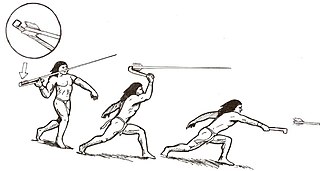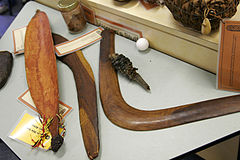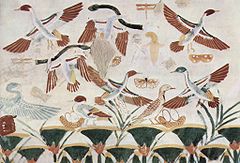
A boomerang is a thrown tool typically constructed with aerofoil sections and designed to spin about an axis perpendicular to the direction of its flight. A returning boomerang is designed to return to the thrower, while a non-returning boomerang is designed as a weapon to be thrown straight and is traditionally used by some Aboriginal Australians for hunting.

A sling is a projectile weapon typically used to throw a blunt projectile such as a stone, clay, or lead "sling-bullet". It is also known as the shepherd's sling or slingshot. Someone who specializes in using slings is called a slinger.
A spear is a pole weapon consisting of a shaft, usually of wood, with a pointed head. The head may be simply the sharpened end of the shaft itself, as is the case with fire hardened spears, or it may be made of a more durable material fastened to the shaft, such as bone, flint, obsidian, copper, bronze, iron, or steel. The most common design for hunting and/or warfare, since ancient times has incorporated a metal spearhead shaped like a triangle, lozenge, or leaf. The heads of fishing spears usually feature multiple sharp points, with or without barbs.

A spear-thrower, spear-throwing lever, or atlatl is a tool that uses leverage to achieve greater velocity in dart or javelin-throwing, and includes a bearing surface that allows the user to store energy during the throw.

Ballistics is the field of mechanics concerned with the launching, flight behaviour and impact effects of projectiles, especially ranged weapon munitions such as bullets, unguided bombs, rockets or the like; the science or art of designing and accelerating projectiles so as to achieve a desired performance.

A club is a short staff or stick, usually made of wood, wielded as a weapon since prehistory. There are several examples of blunt-force trauma caused by clubs in the past, including at the site of Nataruk in Turkana, Kenya, described as the scene of a prehistoric conflict between bands of hunter-gatherers 10,000 years ago.

A ranged weapon is any weapon that can engage targets beyond hand-to-hand distance, i.e. at distances greater than the physical reach of the user holding the weapon itself. The act of using such a weapon is also known as shooting. It is sometimes also called projectile weapon or missile weapon because it typically works by launching solid projectiles ("missiles"), though technically a fluid-projector and a directed-energy weapon are also ranged weapons. In contrast, a weapon intended to be used in hand-to-hand combat is called a melee weapon.
Darts are airborne ranged weapons. They are designed to fly such that a sharp, often weighted point will strike first. They can be distinguished from javelins by the presence of fletching and a shaft that is shorter and/or more flexible. Darts can be propelled by hand or with the aid of a hand-held implement such as a blowgun. They can be distinguished from arrows because they are not used with a bow.

Australian Aboriginal artefacts include a variety of cultural artefacts used by Aboriginal Australians. Most Aboriginal artefacts were multi-purpose and could be used for a variety of different occupations. Spears, clubs, boomerangs and shields were used generally as weapons for hunting and in warfare. Watercraft technology artefacts in the form of dugout and bark canoes were used for transport and for fishing. Stone artefacts include cutting tools and grinding stones to hunt and make food. Coolamons and carriers such as dillybags, allowed Aboriginal peoples to carry water, food and cradle babies. Message sticks were used for communication, and ornamental artefacts for decorative and ceremonial purposes. Aboriginal children’s toys were used to both entertain and educate.

A woomera is an Australian Aboriginal wooden spear-throwing device. Similar to an atlatl, it serves as an extension of the human arm, enabling a spear to travel at a greater speed and force than possible with only the arm.

Coolamon is an anglicised version of the Wiradjuric word guliman used to describe an Australian Aboriginal carrying vessel.

Ancient Egypt was an ancient civilization of eastern North Africa, concentrated along the northern reaches of the Nile River in Egypt. The civilization coalesced around 3150 BC with the political unification of Upper and Lower Egypt under the first pharaoh, and it developed over the next three millennia. Its history occurred in a series of stable kingdoms, separated by periods of relative instability known as intermediate periods. Ancient Egypt reached its pinnacle during the New Kingdom, after which it entered a period of slow decline. Egypt was conquered by a succession of foreign powers in the late period, and the rule of the pharaohs officially ended in 31 BC, when the early Roman Empire conquered Egypt and made it a province. Although the Egyptian military forces in the Old and Middle kingdoms were well maintained, the new form that emerged in the New Kingdom showed the state becoming more organized to serve its needs.
Hunting weapons are weapons designed or used primarily for hunting game animals for food or sport, as distinct from defensive weapons or weapons used primarily in warfare.

The Schöningen spears are a set of ten wooden weapons from the Palaeolithic Age that were excavated between 1994 and 1999 from the 'Spear Horizon' in the open-cast lignite mine in Schöningen, Helmstedt district, Germany. The spears are the oldest hunting weapons discovered and were found together with animal bones and stone and bone tools. Being used by the oldest known group of hunters, they provided never before uncovered proof that early human ancestors were much closer to modern humans in both complex social structure and technical ability than thought before. The excavations took place under the management of Hartmut Thieme of the Lower Saxony State Service for Cultural Heritage (NLD).

Listed here are the weapons of pencak silat. The most common are the machete, staff, kris, sickle, spear, and kerambit. Because Southeast Asian society was traditionally based around agriculture, many of these weapons were originally farming tools.

Native American weaponry was used by Native American warriors to hunt and to do battle with other Native American tribes and European colonizers.
Australia has a population of about 25 million, with the Commonwealth Government's 2019 survey estimating there are 640,000 recreational hunters in the country. There are around 5.8 million legally owned guns in Australia, ranging from airguns to single-shot, bolt-action, pump-action, lever-action or semi-automatic firearms.

Throwing is an action which consists in accelerating a projectile and then releasing it so that it follows a ballistic trajectory, usually with the aim of impacting a remote target. This action is best characterized for animals with prehensile limbs: in this case the projectile is grasped, while the limb segments impart a motion of the hand through compounded mechanical advantage. For other animals, the definition of throwing is somewhat unclear, as other actions such as spitting or spraying may or may not be included.

The Yuwibara, also written Yuibera and Juipera and also known as Yuwi, after their language, are an Aboriginal Australian people, originating from the area around present-day Mackay, on the east coast of Queensland, Australia.

















